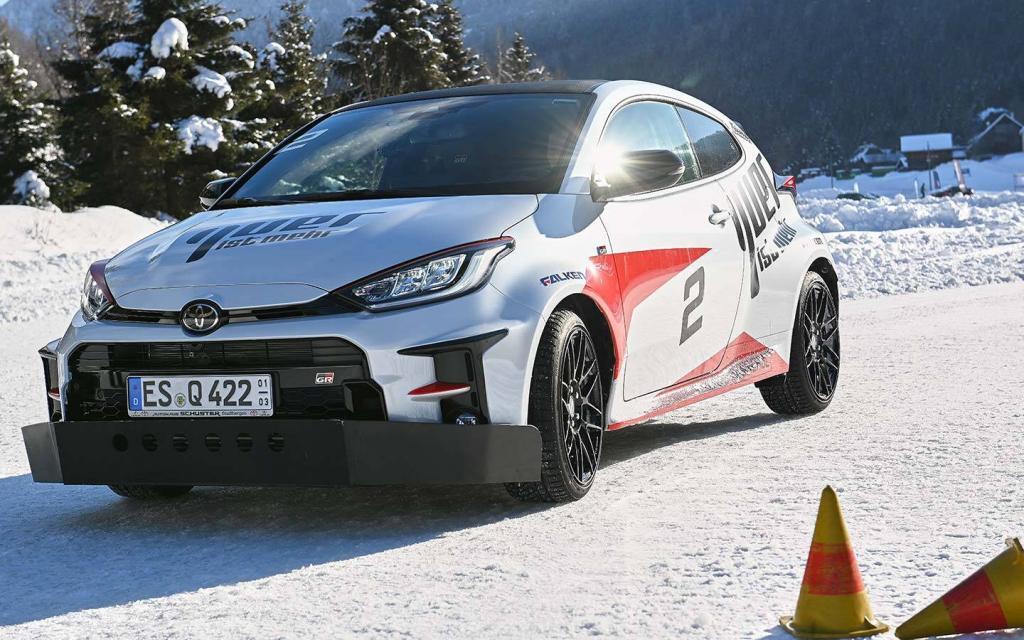Ice drifting with the Falken Eurowinter HS02 Pro.
This is a winter tyre test I’ve been looking forward to for a while. Why? Because I am about to really push the envelope: Firstly, I hope to learn some new driving skills, and secondly, I’ll be taking Falken Tyre’s current winter tyres well beyond their normal street limitations.
After all, driving in winter on central Europe’s serviced open roads has become less and less a case of navigating anything more than a smattering of wet snow and maybe some ice. But if it does get frosty and white, then your attention is most likely to be on the other road users. Even if the roads were devoid of other motorists and pedestrians, you’d still be strongly advised against attempting to get things going sideways at speed.
So now imagine a huge expanse of snow and ice, a race-spec 4×4, the friendly guidance of the experienced @queristmehr.de instructors, and no-one else to get in the way. Time to buckle up…

I reached the promised plot of land shortly after exiting the Tauerntunnel. Thankfully, the erratic temperatures and forecasts of the last couple of weeks had dispersed. The thermometer had settled at -14°C, and blessed us with an abundance of crunchy snow and firm-packed ice under clear blue skies. Perfect conditions for snow and ice training on Falken’s Eurowinter HS02 Pro.
Available in 47 different configurations with V and W ratings for rim sizes between 17” and 21”, our cars are fitted with the 225/40R18. The HS02 has a characteristic 3-zone profile for superior drainage and improved wet road performance. Whereas the inner profile is designed for snow and slush, the outer area is responsible for taking care of dry and wet surfaces.


Keeping today’s objective in mind, we were less interested in the wet and dry performance and relied mostly on the specially formed Miura-Ori 3D sipes designed to improve traction and braking on icy surfaces.
After a brief introduction, we were asked to settle in to the 261 BHP Toyota GR Yaris with a curb weight of 1,250 kg—a power-to-weight ratio dependent upon traction if we want to put the horsepower and torque to good use.
And then I drove out onto the track with an instructor beside me. After all, this is about experiencing danger, not just talking about it. The test track is divided into several zones which build upon each other. The first exercise was to drive a slalom through a line of pylons. This was just to help get a feel for the car and the surface. Ice, ice and more ice, framed by a rise of snow.

It’s my turn. First gear. Second. A few moments and I was sprinting with 50 km/h through the pylons. To start off with, the Toyota was set up with an even 50:50 power distribution to each axle. ESP muted. Then the instructor changed the setup to track mode: 70% to the rear axle. Things quickly got more exciting and the tyres had their work cut out for them.
It took a couple of circuits going through the slalom before my confidence started to grow. I was nearing a calculated and controlled drift. The next two sections of the track took me to the next level as I learned how to set the car up in premeditated oversteer and drift through the curves as quickly as possible. It was actually quite a revelation just how much grip the tyres had on the ice—not too indifferent to how a free-climber uses his finger tips to gain purchase on the smallest of ledges to further his or her ascent.
It goes without saying that I lost it on more than one occasion and ended up next to the track. There was one particular long left-hander where understeer got the upper hand and the back end of the car ploughed into softer material with a spectacular explosion of snow. I kept my right foot firmly planted and the Yaris GR/HS02 Pro combination clawed me back on to the track.

Half way through the day, we stopped for a break. Closer inspection of the tyres revealed they still looked as if they were brand new and the tread was completely free of any compacted snow or ice. Proof that the sipes were doing exactly what they were designed to do: self clearing.
The final discipline today involved a section where, in addition to load shifting through left and right curves, the surface had undulations built into it. Would the car/tyre combo still be able to reassuringly follow the line? Spoiler: As long as you don’t overdo it, you can actually feel when you’re approaching the limit.
This final challenge drew upon everything I’d learned earlier in the day. At the end of each circuit, I tested how the car braked. Obviously, it took longer to slow down than it would on a dry surface, but the car remained stable and reassuring when steering around an obstacle.
CONCLUSION
During today’s extreme test, the Falken Eurowinter HS02 Pro fulfilled what the designers set out to achieve. This wasn’t supposed to be about durability, or whether or not the tyres would be more economical to drive, but the 14% weight saving, compared to its predecessor, holds promise of improved fuel consumption.
As far as the overall performance on slippery surfaces is concerned (accelerating, braking, cornering), the Falken HS02 Pro fulfilled its promise. I felt confident in every situation and was able to keep the Yaris GR under control in situations well beyond those normally encountered on the highway.
falkentyre.com | quer-ist-mehr.de
Photography: Stefan Knopp, Michael Decher







